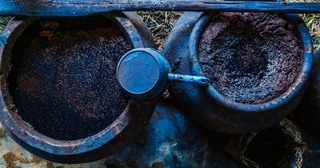In today's world, where sustainability and eco-friendliness are becoming increasingly important, natural plant dyes offer a wonderful alternative to synthetic dyes for coloring clothing. Derived from various plants, these dyes not only provide vibrant and unique hues but also offer several advantages over their chemical counterparts.
In this article, we will explore the advantages, disadvantages, and potential pitfalls of using natural plant dyes for clothing. Additionally, we will provide insights into the process of making clothes dye with plants and suggest some plants and vegetables that are excellent for fabric dyeing.
Advantages of Natural Plant Dyes
Environmentally friendly
Natural plant dyes are derived from renewable resources, making them a sustainable choice for eco-conscious individuals. Unlike synthetic dyes, plant-based dyes are biodegradable and do not contribute to the pollution of waterways or harm aquatic life.

Health benefits
Synthetic dyes often contain toxic chemicals that can be harmful to human health, especially for those with sensitivities or allergies. Natural plant dyes, on the other hand, are non-toxic and pose minimal risks to both the dyer and the wearer of dyed clothing.
Unique and varied colors
Natural plant dyes offer a wide range of colors that are often rich, earthy, and uniquely nuanced. From vibrant yellows obtained from turmeric to deep blues from indigo, these dyes provide a natural and rustic charm that is difficult to replicate with synthetic dyes.
Disadvantages and Potential Pitfalls
Color fastness
While some natural dyes offer excellent color fastness, others may fade or change over time when exposed to sunlight, washing, or other external factors. It is important to conduct colorfastness tests and use appropriate mordants (substances that help fix dyes) to enhance the durability of the dye.
Availability and consistency
The availability of certain plants and their dyeing properties may vary depending on factors such as geographical location, climate, and season. Additionally, the color obtained from natural plant dyes can be influenced by variations in plant material, water quality, and dyeing techniques. Achieving consistent results may require experimentation and expertise.
Time and effort
Natural dyeing processes often require more time and effort compared to synthetic dyes. Extracting dye from plant materials, preparing the fabric, and achieving desired colors may involve multiple steps and require patience and attention to detail.
How to Make Clothes Dye with Plants:
Selection of plants: Choose plants that are known for their dyeing properties. Examples include madder root (red), turmeric (yellow), indigo (blue), onion skins (orange), and walnut husks (brown).

Extraction: Extract the dye by simmering the plant material in water. The dye can be obtained from various parts of the plant, such as leaves, roots, flowers, or bark. Strain the liquid to remove any solid particles.
Preparing the fabric: Scour the fabric to remove any impurities or finishes that may interfere with dye absorption. Natural fibers such as cotton, silk, linen, and wool tend to take up dyes more readily than synthetic fabrics.
Mordanting: Mordants help fix the dye to the fabric, improve colorfastness, and alter the shade of the dye. Common mordants include alum, iron, copper, and tannin. Follow instructions for mordanting specific to the plant dye you are using.
Dyeing process: Immerse the fabric in the dye bath and simmer gently. The length of time required for dye absorption depends on the desired depth of color. Stir occasionally to ensure even dye distribution. Once the desired color is achieved, rinse the fabric thoroughly and allow it to dry.
Plants and Vegetables for Fabric Dyeing:

- Turmeric: Provides vibrant yellow tones.
- Indigo: Yields beautiful shades of blue.
- Madder root: Produces rich reds and oranges.
- Onion skins: Imparts warm shades of orange and brown.
- Walnut husks: Creates earthy browns.
- Avocado pits and skins: Offer soft pinks and blush tones.
- Elderberries: Produce purple and lavender hues.
It's important to note that the intensity and color achieved may vary depending on factors such as the concentration of the dye, mordant used, and the fabric's natural color.
Natural plant dyes provide an eco-friendly and unique alternative to synthetic dyes for coloring clothing. While they come with advantages such as environmental sustainability, health benefits, and a wide range of colors, they also have considerations, including color fastness, availability, and the need for time and effort.
By following the dyeing process and experimenting with different plants and mordants, you can create beautiful, naturally dyed garments that reflect your commitment to sustainable fashion.

